Economics for Business: Copper Demand and Supply in Australia Analysis
VerifiedAdded on 2020/03/01
|7
|1570
|43
Report
AI Summary
This report provides an economic analysis of the copper market in Australia, focusing on the interplay of demand and supply. It examines how increasing demand, driven by the growth of electric vehicles and renewable energy sectors, is impacting copper prices. The report highlights Australia's position as a major copper producer and discusses the influence of urbanization in developing economies on demand. It applies economic theories, including demand and supply curves and the concept of inelastic demand, to explain price fluctuations and market equilibrium. Furthermore, the report emphasizes the potential for future supply shortages and suggests government interventions such as promoting new copper resource discoveries and implementing price flooring policies to maintain market stability. The analysis incorporates data from various sources, including industry reports and economic forecasts, to support its conclusions.
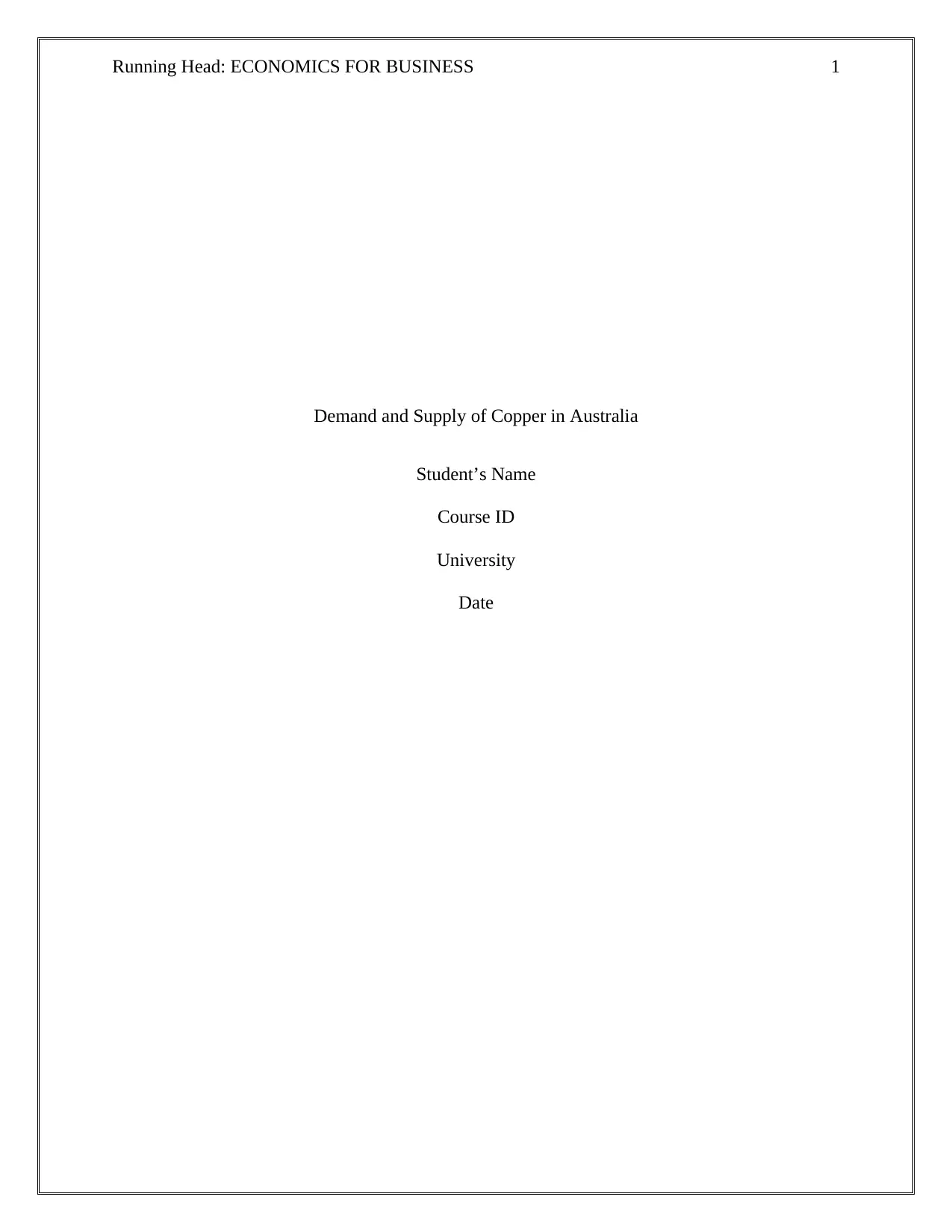
Running Head: ECONOMICS FOR BUSINESS 1
Demand and Supply of Copper in Australia
Student’s Name
Course ID
University
Date
Demand and Supply of Copper in Australia
Student’s Name
Course ID
University
Date
Paraphrase This Document
Need a fresh take? Get an instant paraphrase of this document with our AI Paraphraser
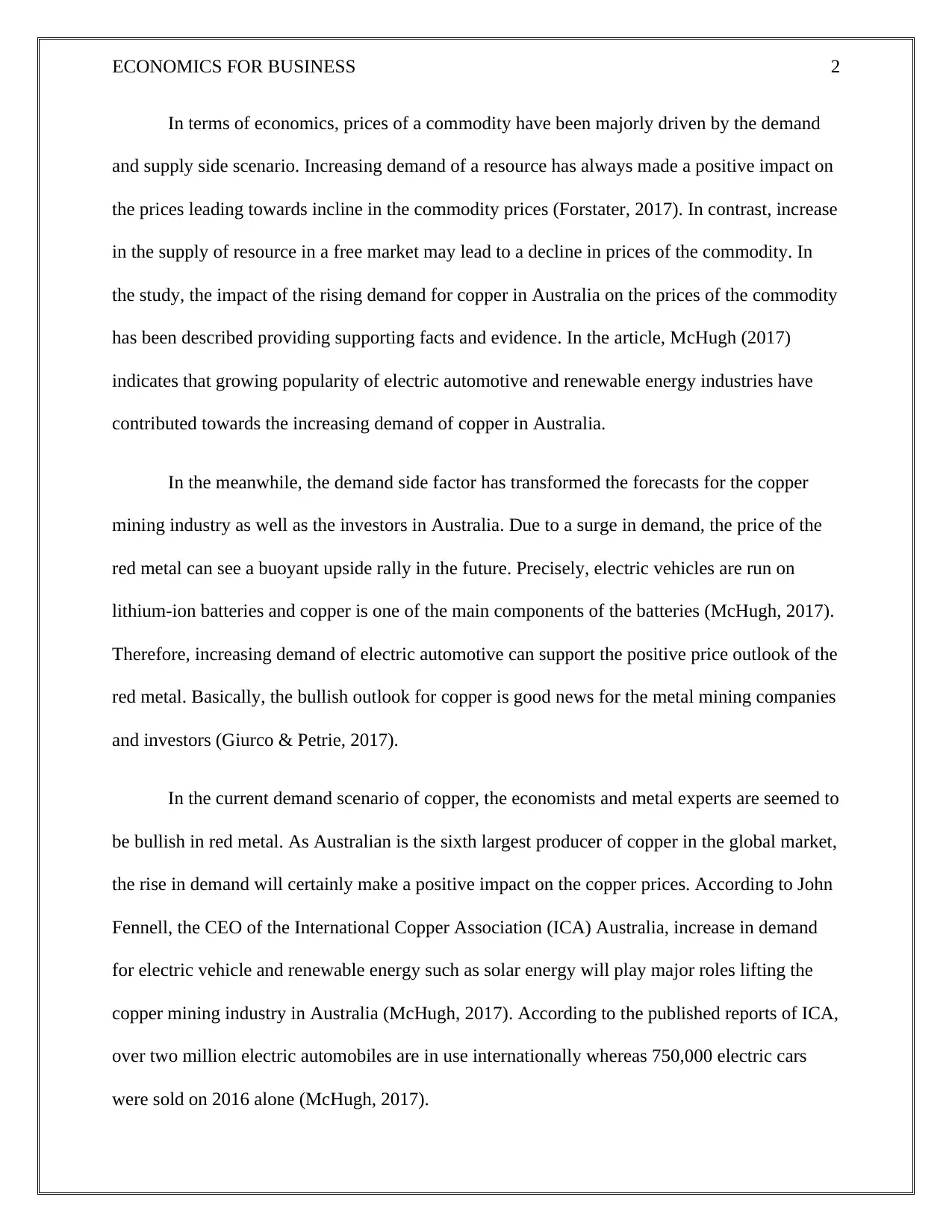
ECONOMICS FOR BUSINESS 2
In terms of economics, prices of a commodity have been majorly driven by the demand
and supply side scenario. Increasing demand of a resource has always made a positive impact on
the prices leading towards incline in the commodity prices (Forstater, 2017). In contrast, increase
in the supply of resource in a free market may lead to a decline in prices of the commodity. In
the study, the impact of the rising demand for copper in Australia on the prices of the commodity
has been described providing supporting facts and evidence. In the article, McHugh (2017)
indicates that growing popularity of electric automotive and renewable energy industries have
contributed towards the increasing demand of copper in Australia.
In the meanwhile, the demand side factor has transformed the forecasts for the copper
mining industry as well as the investors in Australia. Due to a surge in demand, the price of the
red metal can see a buoyant upside rally in the future. Precisely, electric vehicles are run on
lithium-ion batteries and copper is one of the main components of the batteries (McHugh, 2017).
Therefore, increasing demand of electric automotive can support the positive price outlook of the
red metal. Basically, the bullish outlook for copper is good news for the metal mining companies
and investors (Giurco & Petrie, 2017).
In the current demand scenario of copper, the economists and metal experts are seemed to
be bullish in red metal. As Australian is the sixth largest producer of copper in the global market,
the rise in demand will certainly make a positive impact on the copper prices. According to John
Fennell, the CEO of the International Copper Association (ICA) Australia, increase in demand
for electric vehicle and renewable energy such as solar energy will play major roles lifting the
copper mining industry in Australia (McHugh, 2017). According to the published reports of ICA,
over two million electric automobiles are in use internationally whereas 750,000 electric cars
were sold on 2016 alone (McHugh, 2017).
In terms of economics, prices of a commodity have been majorly driven by the demand
and supply side scenario. Increasing demand of a resource has always made a positive impact on
the prices leading towards incline in the commodity prices (Forstater, 2017). In contrast, increase
in the supply of resource in a free market may lead to a decline in prices of the commodity. In
the study, the impact of the rising demand for copper in Australia on the prices of the commodity
has been described providing supporting facts and evidence. In the article, McHugh (2017)
indicates that growing popularity of electric automotive and renewable energy industries have
contributed towards the increasing demand of copper in Australia.
In the meanwhile, the demand side factor has transformed the forecasts for the copper
mining industry as well as the investors in Australia. Due to a surge in demand, the price of the
red metal can see a buoyant upside rally in the future. Precisely, electric vehicles are run on
lithium-ion batteries and copper is one of the main components of the batteries (McHugh, 2017).
Therefore, increasing demand of electric automotive can support the positive price outlook of the
red metal. Basically, the bullish outlook for copper is good news for the metal mining companies
and investors (Giurco & Petrie, 2017).
In the current demand scenario of copper, the economists and metal experts are seemed to
be bullish in red metal. As Australian is the sixth largest producer of copper in the global market,
the rise in demand will certainly make a positive impact on the copper prices. According to John
Fennell, the CEO of the International Copper Association (ICA) Australia, increase in demand
for electric vehicle and renewable energy such as solar energy will play major roles lifting the
copper mining industry in Australia (McHugh, 2017). According to the published reports of ICA,
over two million electric automobiles are in use internationally whereas 750,000 electric cars
were sold on 2016 alone (McHugh, 2017).
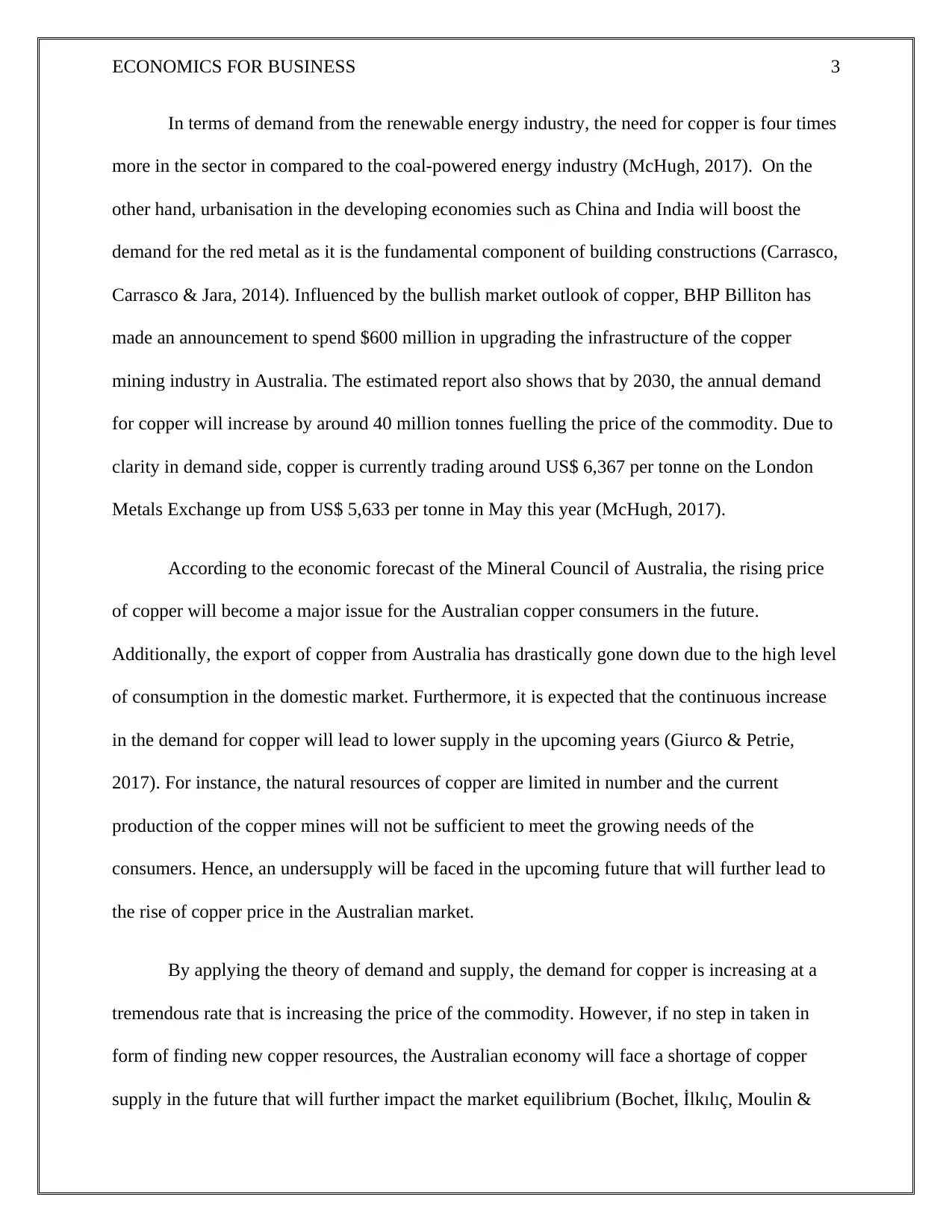
ECONOMICS FOR BUSINESS 3
In terms of demand from the renewable energy industry, the need for copper is four times
more in the sector in compared to the coal-powered energy industry (McHugh, 2017). On the
other hand, urbanisation in the developing economies such as China and India will boost the
demand for the red metal as it is the fundamental component of building constructions (Carrasco,
Carrasco & Jara, 2014). Influenced by the bullish market outlook of copper, BHP Billiton has
made an announcement to spend $600 million in upgrading the infrastructure of the copper
mining industry in Australia. The estimated report also shows that by 2030, the annual demand
for copper will increase by around 40 million tonnes fuelling the price of the commodity. Due to
clarity in demand side, copper is currently trading around US$ 6,367 per tonne on the London
Metals Exchange up from US$ 5,633 per tonne in May this year (McHugh, 2017).
According to the economic forecast of the Mineral Council of Australia, the rising price
of copper will become a major issue for the Australian copper consumers in the future.
Additionally, the export of copper from Australia has drastically gone down due to the high level
of consumption in the domestic market. Furthermore, it is expected that the continuous increase
in the demand for copper will lead to lower supply in the upcoming years (Giurco & Petrie,
2017). For instance, the natural resources of copper are limited in number and the current
production of the copper mines will not be sufficient to meet the growing needs of the
consumers. Hence, an undersupply will be faced in the upcoming future that will further lead to
the rise of copper price in the Australian market.
By applying the theory of demand and supply, the demand for copper is increasing at a
tremendous rate that is increasing the price of the commodity. However, if no step in taken in
form of finding new copper resources, the Australian economy will face a shortage of copper
supply in the future that will further impact the market equilibrium (Bochet, İlkılıç, Moulin &
In terms of demand from the renewable energy industry, the need for copper is four times
more in the sector in compared to the coal-powered energy industry (McHugh, 2017). On the
other hand, urbanisation in the developing economies such as China and India will boost the
demand for the red metal as it is the fundamental component of building constructions (Carrasco,
Carrasco & Jara, 2014). Influenced by the bullish market outlook of copper, BHP Billiton has
made an announcement to spend $600 million in upgrading the infrastructure of the copper
mining industry in Australia. The estimated report also shows that by 2030, the annual demand
for copper will increase by around 40 million tonnes fuelling the price of the commodity. Due to
clarity in demand side, copper is currently trading around US$ 6,367 per tonne on the London
Metals Exchange up from US$ 5,633 per tonne in May this year (McHugh, 2017).
According to the economic forecast of the Mineral Council of Australia, the rising price
of copper will become a major issue for the Australian copper consumers in the future.
Additionally, the export of copper from Australia has drastically gone down due to the high level
of consumption in the domestic market. Furthermore, it is expected that the continuous increase
in the demand for copper will lead to lower supply in the upcoming years (Giurco & Petrie,
2017). For instance, the natural resources of copper are limited in number and the current
production of the copper mines will not be sufficient to meet the growing needs of the
consumers. Hence, an undersupply will be faced in the upcoming future that will further lead to
the rise of copper price in the Australian market.
By applying the theory of demand and supply, the demand for copper is increasing at a
tremendous rate that is increasing the price of the commodity. However, if no step in taken in
form of finding new copper resources, the Australian economy will face a shortage of copper
supply in the future that will further impact the market equilibrium (Bochet, İlkılıç, Moulin &
⊘ This is a preview!⊘
Do you want full access?
Subscribe today to unlock all pages.

Trusted by 1+ million students worldwide
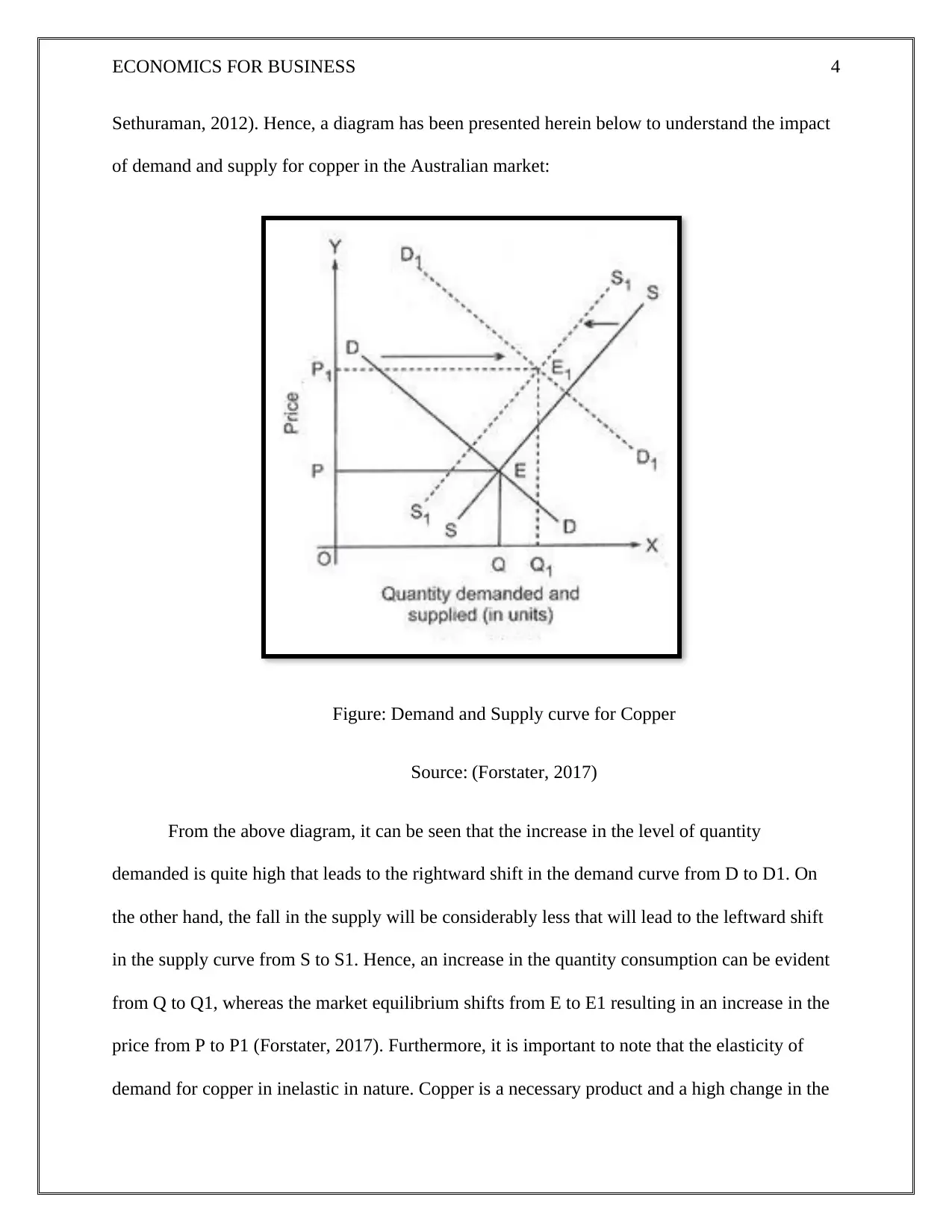
ECONOMICS FOR BUSINESS 4
Sethuraman, 2012). Hence, a diagram has been presented herein below to understand the impact
of demand and supply for copper in the Australian market:
Figure: Demand and Supply curve for Copper
Source: (Forstater, 2017)
From the above diagram, it can be seen that the increase in the level of quantity
demanded is quite high that leads to the rightward shift in the demand curve from D to D1. On
the other hand, the fall in the supply will be considerably less that will lead to the leftward shift
in the supply curve from S to S1. Hence, an increase in the quantity consumption can be evident
from Q to Q1, whereas the market equilibrium shifts from E to E1 resulting in an increase in the
price from P to P1 (Forstater, 2017). Furthermore, it is important to note that the elasticity of
demand for copper in inelastic in nature. Copper is a necessary product and a high change in the
Sethuraman, 2012). Hence, a diagram has been presented herein below to understand the impact
of demand and supply for copper in the Australian market:
Figure: Demand and Supply curve for Copper
Source: (Forstater, 2017)
From the above diagram, it can be seen that the increase in the level of quantity
demanded is quite high that leads to the rightward shift in the demand curve from D to D1. On
the other hand, the fall in the supply will be considerably less that will lead to the leftward shift
in the supply curve from S to S1. Hence, an increase in the quantity consumption can be evident
from Q to Q1, whereas the market equilibrium shifts from E to E1 resulting in an increase in the
price from P to P1 (Forstater, 2017). Furthermore, it is important to note that the elasticity of
demand for copper in inelastic in nature. Copper is a necessary product and a high change in the
Paraphrase This Document
Need a fresh take? Get an instant paraphrase of this document with our AI Paraphraser
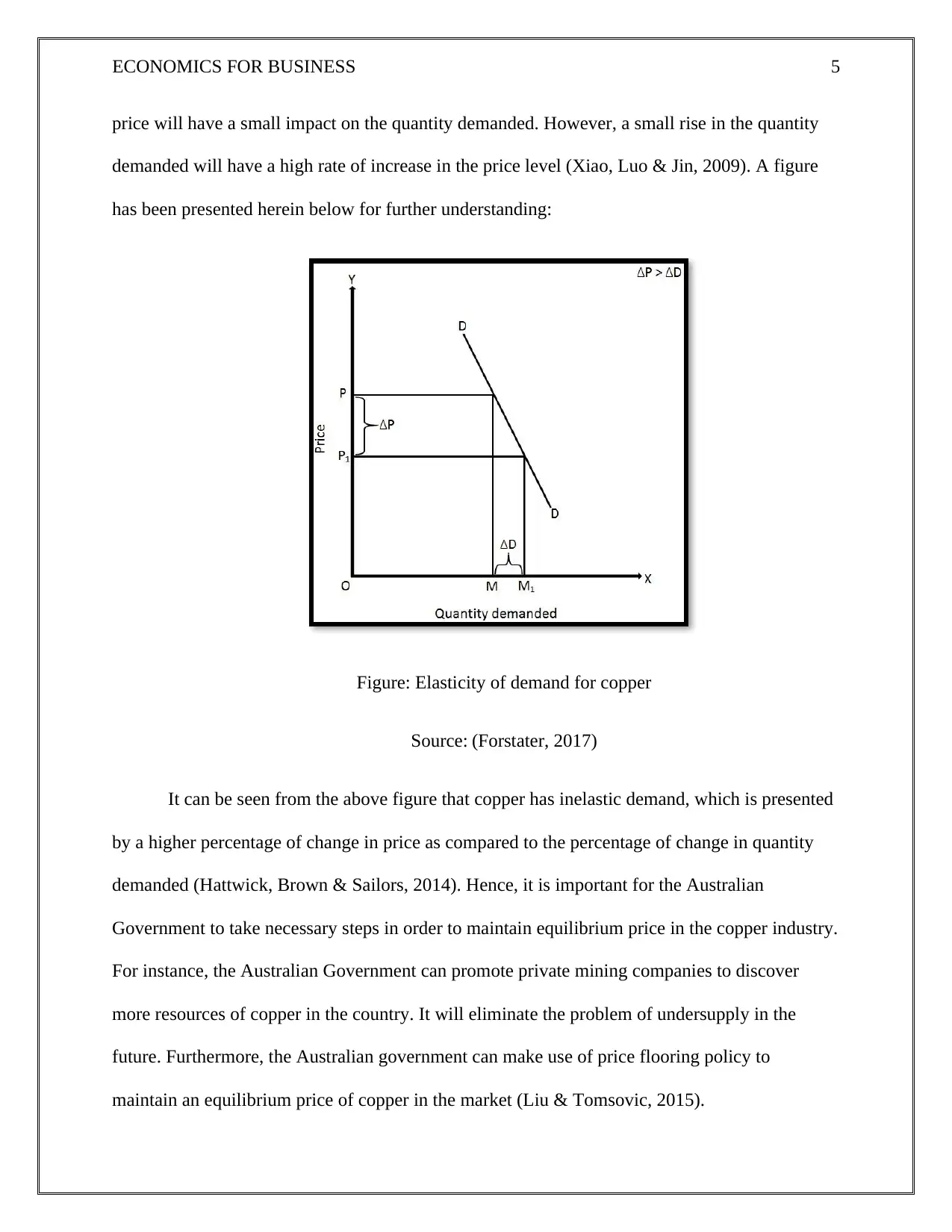
ECONOMICS FOR BUSINESS 5
price will have a small impact on the quantity demanded. However, a small rise in the quantity
demanded will have a high rate of increase in the price level (Xiao, Luo & Jin, 2009). A figure
has been presented herein below for further understanding:
Figure: Elasticity of demand for copper
Source: (Forstater, 2017)
It can be seen from the above figure that copper has inelastic demand, which is presented
by a higher percentage of change in price as compared to the percentage of change in quantity
demanded (Hattwick, Brown & Sailors, 2014). Hence, it is important for the Australian
Government to take necessary steps in order to maintain equilibrium price in the copper industry.
For instance, the Australian Government can promote private mining companies to discover
more resources of copper in the country. It will eliminate the problem of undersupply in the
future. Furthermore, the Australian government can make use of price flooring policy to
maintain an equilibrium price of copper in the market (Liu & Tomsovic, 2015).
price will have a small impact on the quantity demanded. However, a small rise in the quantity
demanded will have a high rate of increase in the price level (Xiao, Luo & Jin, 2009). A figure
has been presented herein below for further understanding:
Figure: Elasticity of demand for copper
Source: (Forstater, 2017)
It can be seen from the above figure that copper has inelastic demand, which is presented
by a higher percentage of change in price as compared to the percentage of change in quantity
demanded (Hattwick, Brown & Sailors, 2014). Hence, it is important for the Australian
Government to take necessary steps in order to maintain equilibrium price in the copper industry.
For instance, the Australian Government can promote private mining companies to discover
more resources of copper in the country. It will eliminate the problem of undersupply in the
future. Furthermore, the Australian government can make use of price flooring policy to
maintain an equilibrium price of copper in the market (Liu & Tomsovic, 2015).
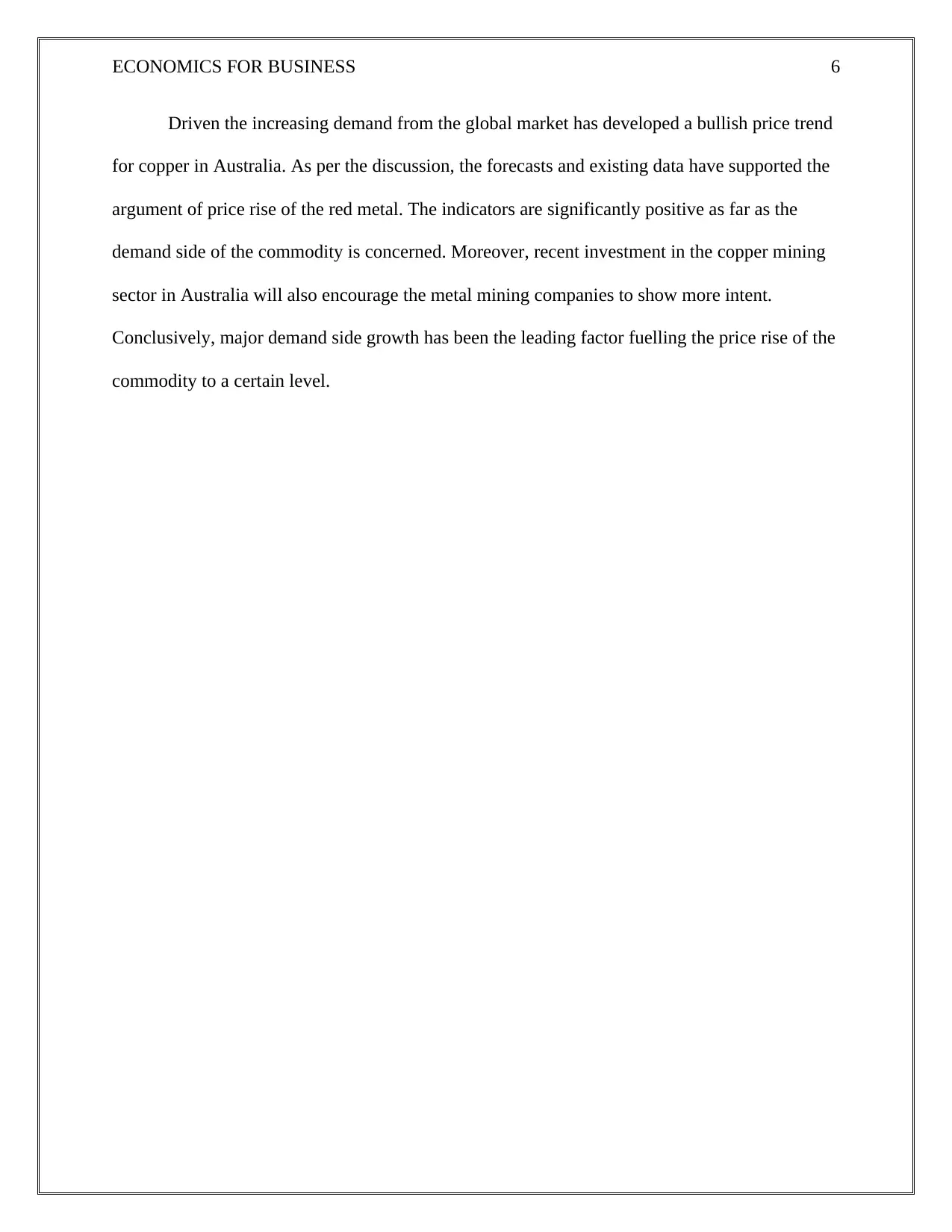
ECONOMICS FOR BUSINESS 6
Driven the increasing demand from the global market has developed a bullish price trend
for copper in Australia. As per the discussion, the forecasts and existing data have supported the
argument of price rise of the red metal. The indicators are significantly positive as far as the
demand side of the commodity is concerned. Moreover, recent investment in the copper mining
sector in Australia will also encourage the metal mining companies to show more intent.
Conclusively, major demand side growth has been the leading factor fuelling the price rise of the
commodity to a certain level.
Driven the increasing demand from the global market has developed a bullish price trend
for copper in Australia. As per the discussion, the forecasts and existing data have supported the
argument of price rise of the red metal. The indicators are significantly positive as far as the
demand side of the commodity is concerned. Moreover, recent investment in the copper mining
sector in Australia will also encourage the metal mining companies to show more intent.
Conclusively, major demand side growth has been the leading factor fuelling the price rise of the
commodity to a certain level.
⊘ This is a preview!⊘
Do you want full access?
Subscribe today to unlock all pages.

Trusted by 1+ million students worldwide
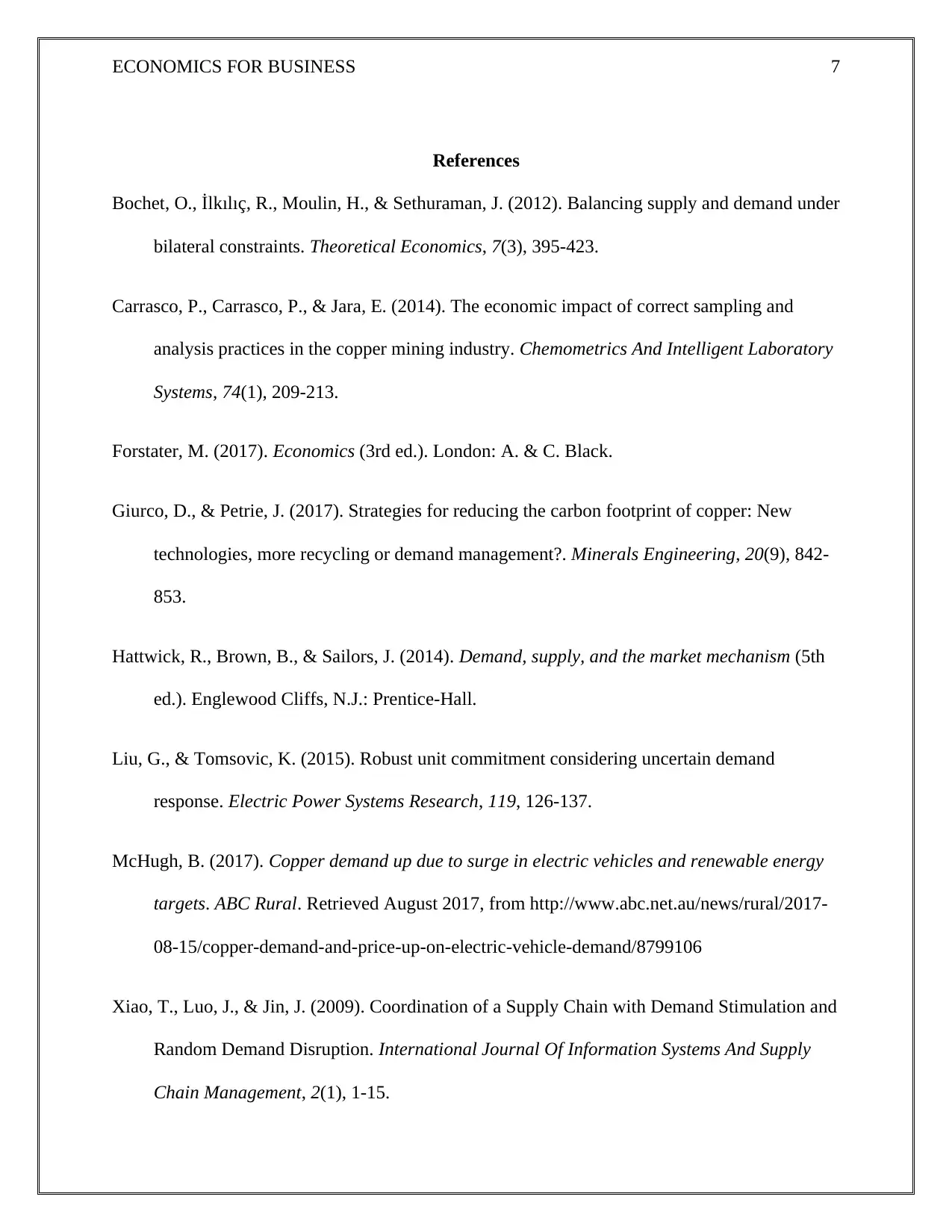
ECONOMICS FOR BUSINESS 7
References
Bochet, O., İlkılıç, R., Moulin, H., & Sethuraman, J. (2012). Balancing supply and demand under
bilateral constraints. Theoretical Economics, 7(3), 395-423.
Carrasco, P., Carrasco, P., & Jara, E. (2014). The economic impact of correct sampling and
analysis practices in the copper mining industry. Chemometrics And Intelligent Laboratory
Systems, 74(1), 209-213.
Forstater, M. (2017). Economics (3rd ed.). London: A. & C. Black.
Giurco, D., & Petrie, J. (2017). Strategies for reducing the carbon footprint of copper: New
technologies, more recycling or demand management?. Minerals Engineering, 20(9), 842-
853.
Hattwick, R., Brown, B., & Sailors, J. (2014). Demand, supply, and the market mechanism (5th
ed.). Englewood Cliffs, N.J.: Prentice-Hall.
Liu, G., & Tomsovic, K. (2015). Robust unit commitment considering uncertain demand
response. Electric Power Systems Research, 119, 126-137.
McHugh, B. (2017). Copper demand up due to surge in electric vehicles and renewable energy
targets. ABC Rural. Retrieved August 2017, from http://www.abc.net.au/news/rural/2017-
08-15/copper-demand-and-price-up-on-electric-vehicle-demand/8799106
Xiao, T., Luo, J., & Jin, J. (2009). Coordination of a Supply Chain with Demand Stimulation and
Random Demand Disruption. International Journal Of Information Systems And Supply
Chain Management, 2(1), 1-15.
References
Bochet, O., İlkılıç, R., Moulin, H., & Sethuraman, J. (2012). Balancing supply and demand under
bilateral constraints. Theoretical Economics, 7(3), 395-423.
Carrasco, P., Carrasco, P., & Jara, E. (2014). The economic impact of correct sampling and
analysis practices in the copper mining industry. Chemometrics And Intelligent Laboratory
Systems, 74(1), 209-213.
Forstater, M. (2017). Economics (3rd ed.). London: A. & C. Black.
Giurco, D., & Petrie, J. (2017). Strategies for reducing the carbon footprint of copper: New
technologies, more recycling or demand management?. Minerals Engineering, 20(9), 842-
853.
Hattwick, R., Brown, B., & Sailors, J. (2014). Demand, supply, and the market mechanism (5th
ed.). Englewood Cliffs, N.J.: Prentice-Hall.
Liu, G., & Tomsovic, K. (2015). Robust unit commitment considering uncertain demand
response. Electric Power Systems Research, 119, 126-137.
McHugh, B. (2017). Copper demand up due to surge in electric vehicles and renewable energy
targets. ABC Rural. Retrieved August 2017, from http://www.abc.net.au/news/rural/2017-
08-15/copper-demand-and-price-up-on-electric-vehicle-demand/8799106
Xiao, T., Luo, J., & Jin, J. (2009). Coordination of a Supply Chain with Demand Stimulation and
Random Demand Disruption. International Journal Of Information Systems And Supply
Chain Management, 2(1), 1-15.
1 out of 7
Related Documents
Your All-in-One AI-Powered Toolkit for Academic Success.
+13062052269
info@desklib.com
Available 24*7 on WhatsApp / Email
![[object Object]](/_next/static/media/star-bottom.7253800d.svg)
Unlock your academic potential
Copyright © 2020–2025 A2Z Services. All Rights Reserved. Developed and managed by ZUCOL.





